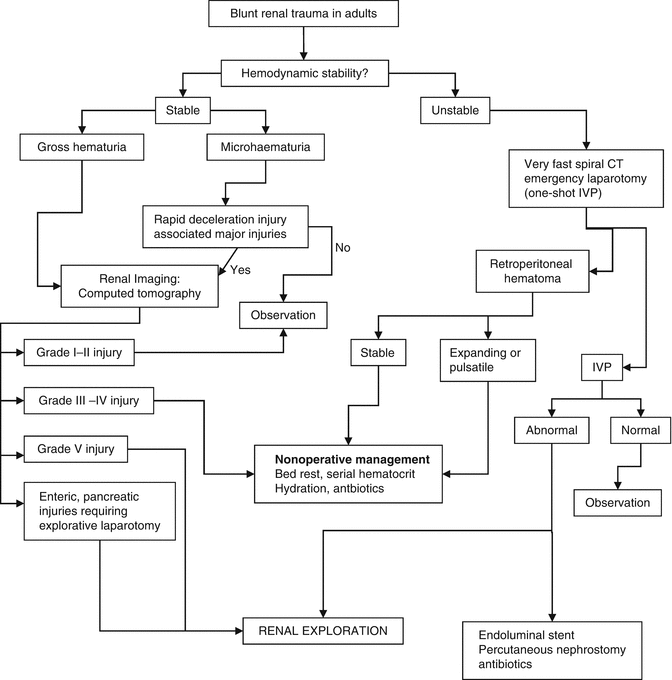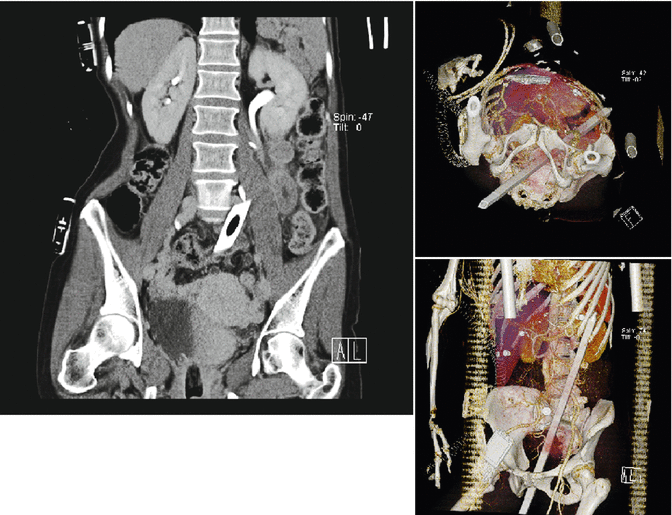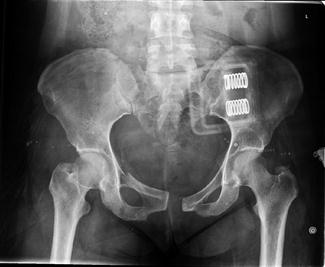1
Contusion or nonexpanding subcapsular hematoma. No laceration
2
Nonexpanding perirenal hematoma, cortical laceration < 1 cm deep w/o extravasation
3
Cortical laceration > 1 cm w/o urinary extravasation
4
Laceration: through corticomedullary junction into collecting system or
Vascular: segmental renal artery or vein injury with contained hematoma
5
Laceration: shuttered kidney or
Vascular: renal pedicle injury or avulsion
11.2.1 Clinical Symptoms
Gross hematuria might be present but it does not correlate with the degree of injury since major injuries such as renal pedicle lacerations or disruption of the ureteropelvic junction may occur without hematuria. Blood transfusion requirements are an indirect indication of the rate of blood loss.
11.2.2 Imaging Studies
Patients with blunt renal, microscopic hematuria, stable vital signs in the absence of deceleration trauma usually do not have to undergo any specific imaging studies [1, 4, 9].
Patients with gross hematuria, penetrating injuries with suspected renal involvement, and instable vital signs must undergo immediate imaging studies (Fig. 11.1) [1, 5]. CT imaging represents the gold standard for radiographic assessment in suspected renal injury because (1) it defines the location and the extent of injuries, (2) detects contusions and devitalized segments, (3) allows for visualization of the entire retroperitoneum, (4) allows for assessment of the renal pedicle, and (5) detects urinary extravasations [1, 5, 9, 10]. Spiral CT scans are advantageous due to shorter scanning times, but do not allow the identification of injuries to the renal collecting system, thereby necessitating the use of delayed CT scans. Angiography is important only for superselective embolization in the management of persisting or delayed hemorrhage.


Fig. 11.1
Diagnostic and therapeutic algorithm for suspected blunt renal trauma in adults
11.2.3 Treatment
In general, there are several guidelines on treating renal trauma. The management of renal trauma was described in detail by the European Association of Urology [11].
A summary of the various therapeutic approaches is presented in Fig. 11.1. Life-threatening hemodynamic instability or an expanding or pulsatile retroperitoneal hematoma during explorative laparotomy usually represents AAST grade 5 injury and requires immediate surgery [1, 3]. A transperitoneal approach with early occlusion of the pedicle prior to opening of Gerota’s fascia is strongly recommended. In patients with avulsion of the renal pedicle close to the aorta or the inferior vena cava, it might be necessary to clamp the major vessels just above and below the renal pedicle to control bleeding and to explore the retroperitoneum. In patients with significant injuries to the vascular pedicle, nephrectomy is the treatment of choice, unless the kidney can be preserved in cases of solitary organ or bilateral injuries. In patients with bleeding from the renal parenchyma due to penetrating injuries, embolization is advised [4, 6, 11, 12].
Persistent bleeding, injuries to the renal collecting system, the renal pelvis, or the ureter with urinary extravasation are relative indications for surgery [1]. Urinary extravasation may be treated by endoluminal stenting and/or placement of a percutaneous nephrostomy. However, surgical reconstruction is advised in the presence of devitalized fragments and associated enteric and pancreatic injuries [13]. Aggressive surgical management for renal lacerations is associated with a 23 % morbidity rate whereas initial nonoperative treatment resulted in an 85 % morbidity rate.
Hemodynamically stable patients with AAST grade 1 and 2 injuries can be managed nonoperatively with supportive care, bed rest, hydration, and prophylactic antibiotics [4–6].
Stable patients with renal gunshot injuries or stab wounds must be explored if the renal hilum and the collecting system are involved or if persistent bleeding exists.
In patients with significant renal injuries, postoperative observation is extremely important because a variety of delayed complications may occur within the first 30 days of injury. This includes but is not limited to hemorrhage, urinary fistula, arteriovenous fistula, and pseudoaneurysms [2, 14]. Patients must undergo imaging studies if they develop clinical symptoms such as fever, increasing flank pain, persistent bleeding, and arterial hypertension. As for the primary diagnosis, CT scan of the abdomen is the preferred imaging modality.
11.3 Ureteral Trauma
Trauma to the ureter is rare and it accounts for only about 1 % of all genitourinary injuries. Most commonly, ureteral lesions result from iatrogenic injuries (75 %), and only 7 and 18 % result from blunt and penetrating trauma, respectively. The majority of iatrogenic injuries occur after gynecologic interventions (70–75 %), while about 15–20 % result after general surgery and about 10–15 % occur following urologic procedures.
As with all other genitourinary organs, the AAST has classified ureteral injuries according to their severity as indicated in Table 11.2.
Table 11.2
Classification of ureteral injury
Grade | Description of injury |
|---|---|
I | Hematoma only |
II | Laceration < 50 % of circumference |
III | Laceration > 50 % of circumference |
IV | Complete tear < 2 cm of devascularization |
V | Complete tear > 2 cm of devascularization |
11.3.1 Clinical Symptoms
There are no specific clinical symptoms; unspecific symptoms such as meteorism, abdominal distension, and flank pain are caused by retroperitoneal urinoma. Ureteral injury should always be suspected in patients with penetrating abdominal or retroperitoneal injuries, and in patients with blunt deceleration traumas.
11.3.2 Imaging
The most common imaging modality is an intravenous pyelography. It is performed in nearly two-thirds of the patients with suspected ureteral injuries. Typically, IVP demonstrates retroperitoneal extravasation of contrast material. In about 30–50 %, additional retrograde ureteropyelography is performed to verify the location and the extent of the ureteral injury. Small lesions may be managed by the placement of an endoluminal DJ-catheter. In very rare cases, the suspicion of a ureteral injury is based on ultrasound findings of a retroperitoneal fluid collection (urinoma) or a hydronephrosis (Fig. 11.2).


Fig. 11.2
Left ureteral injury with urinoma and hematoma in the small pelvis
11.3.3 Management
In patients with partial tears of the ureter, the most common, simple, and effective measure is placement of a ureteral stent and/or a percutaneous nephrostomy tube.
If iatrogenic ureteral injuries are detected intraoperatively, an endoluminal DJ stent should be placed with the ureteral laceration being closed by interrupted sutures with a monofil suture. Postoperatively, no drain or suction should be placed in order to prevent the development of a urinary fistula.
Reconstruction of grade 3–5 injuries depends on the anatomic localization of the injury. Usually, grade 3 and 5 injuries can be treated by an end-to-end anastomosis. The anastomosis is reconstructed with absorbable sutures after placement of a ureteral catheter, which can stay in place for about 3–4 weeks. Other surgical options are listed in Table 11.3.
Table 11.3
Surgical options to reconstruct ureteral injuries depending on the anatomic level of injury
Level of urethral injury | Options of reconstruction |
|---|---|
Upper third | Transuretero-ureterostomy |
Ureterocalycostomy | |
Ileal replacement of the ureter | |
Percutaneous pyelovesical bypass prosthesis | |
Renal autotransplantation | |
Middle third | Transuretero-ureterostomy |
Boari flap and intravesical reimplantation | |
Ileal replacement of the ureter | |
Lower third | Direct intravesical reimplantation |
Psoas hitch reimplantation | |
Complete ureteral loss | Ileal replacement (delayed)a |
Renal autotransplantation (delayed)a | |
Percutaneous pyelovesical bypass (delayed)a |
11.4 Bladder Trauma
Bladder injuries are one of the most frequent urological injuries in trauma patients. Among abdominal injuries requiring surgical repair, about 2 % involve the bladder [1, 15, 16]. Blunt trauma accounts for about 65–85 % of bladder ruptures whereas penetrating trauma accounts for only about 14–33 % of all bladder injuries. Bladder ruptures in the setting of blunt traumas are classified as extra- or intraperitoneal, triggering the choice between a conservative approach and a surgical correction. Most commonly, extraperitoneal bladder ruptures occur in about 55 % of the cases, followed by intraperitoneal bladder ruptures in 38 %. Combined injuries are rare (5–8 % of cases). Motor vehicle accidents contribute significantly to bladder rupture by blunt trauma. Seventy to ninety-seven percent of patients with bladder trauma have accompanied pelvic fractures, whereas only 5–30 % of the pelvic fractures are associated with bladder injuries [15–20].
The Committee on the Organ Injury Scaling of the American Association for Surgery of Trauma (AAST) classified bladder injuries as shown in Table 11.4.
Table 11.4
AAST organ injury severity scale for the bladder
I | Hematoma | Contusion, intramural hematoma |
I | Laceration | Partial thickness |
II | Laceration | Extraperitoneal bladder wall laceration < 2 cm |
III | Laceration | Extraperitoneal (>2 cm) or intraperitoneal (<2 cm) bladder wall laceration |
IV | Laceration | Intraperitoneal bladder wall laceration > 2 cm |
V | Laceration | Intraperitoneal or extraperitoneal bladder wall laceration extending into the bladder neck or ureteral orifices |
11.4.1 Clinical Symptoms
The two most common signs and symptoms for bladder injuries are gross hematuria (80–100 %) and abdominal tenderness (60–70 %) [15]. Other findings may include the inability to void (rule out: intrapelvic urethral rupture!), bruises over the suprapubic region, and abdominal distension. Depending on the type and extent of associated injuries to the pelvic floor, extravasation of urine may result in swelling of the perineum, scrotum, thighs, and the anterior abdominal wall.
11.4.2 Imaging
The classic combination of pelvic fracture and gross hematuria requires immediate cystourethrography to rule out urethral and/or bladder ruptures [15, 17, 21, 22]. All patients with pelvic ring fractures and gross hematuria should undergo immediate cystography (Figs. 11.3 and 11.4). Since microscopic hematuria is a relative indicator for significant injury, recommendations for the most appropriate imaging studies are sparse in the literature and in the existing guidelines. Imaging of the bladder may be reserved for those with anterior rami fractures (straddle fractures) or Malgaigne type severe ring disruption (Tile III).


Fig. 11.3




Deceleration trauma after a jump from the third floor
Stay updated, free articles. Join our Telegram channel

Full access? Get Clinical Tree







